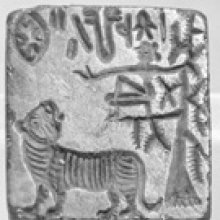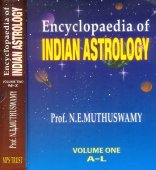Seer: 4 definitions
Introduction:
Seer means something in Hinduism, Sanskrit, Hindi, biology. If you want to know the exact meaning, history, etymology or English translation of this term then check out the descriptions on this page. Add your comment or reference to a book if you want to contribute to this summary article.
Images (photo gallery)
(+1 more images available)
In Hinduism
Shilpashastra (iconography)
Source: Shodhganga: Elements of Art and Architecture in the Trtiyakhanda of the Visnudharmottarapurana (shilpa)Seers refers to the Sages (in Sanskrit: Ṛṣis), who, in ancient times, could visualise everything as portraits in the mind.—From the ancient period till today, many natural objects like trees, flowers, leaves, forests, mountains, sun, moon etc. and natural phenomenon like day and night, the seasons, rain etc. always seem to inspire the artist to make beautiful creations. Even the sages in the Vedic period used to see the surroundings and could visualise everything as portraits in the mind. That is why the sages are called the seers but not doer—ṛṣi darśanāt. So, surroundings and the objects in the surroundings always play a strong role in the conceptualisation of an idea by a painter or an artist.

Shilpashastra (शिल्पशास्त्र, śilpaśāstra) represents the ancient Indian science (shastra) of creative arts (shilpa) such as sculpture, iconography and painting. Closely related to Vastushastra (architecture), they often share the same literature.
Biology (plants and animals)
Source: Google Books: CRC World Dictionary (Regional names)1) Seer in India is the name of a plant defined with Allium sativum in various botanical sources. This page contains potential references in Ayurveda, modern medicine, and other folk traditions or local practices It has the synonym Porrum ophioscorodon Rchb. (among others).
2) Seer is also identified with Hedychium spicatum It has the synonym Gandasulium sieboldii (Wall.) Kuntze (etc.).
Example references for further research on medicinal uses or toxicity (see latin names for full list):
· Monandr. Pl. Scitam. (1825)
· Monandr. Pl. Scitam. (1824)
· Flora of the British India (1892)
· Revisio Generum Plantarum (1891)
· Gardeners Dictionary, ed. 8
· Cycl. (1811)
If you are looking for specific details regarding Seer, for example health benefits, pregnancy safety, chemical composition, diet and recipes, side effects, extract dosage, have a look at these references.

This sections includes definitions from the five kingdoms of living things: Animals, Plants, Fungi, Protists and Monera. It will include both the official binomial nomenclature (scientific names usually in Latin) as well as regional spellings and variants.
Languages of India and abroad
Hindi dictionary
Source: DDSA: A practical Hindi-English dictionarySeer in Hindi refers in English to:—(nf) self cultivated land; (nm) a plough; —[karana] to self-cultivate; —[mem hona] to be under cultivation.—seer (सीर) is alternatively transliterated as Sīra.
...
Nepali dictionary
Source: unoes: Nepali-English DictionarySeer is another spelling for सीर [sīra].—n. 1. a plough; 2. the oxen that plough;
Nepali is the primary language of the Nepalese people counting almost 20 million native speakers. The country of Nepal is situated in the Himalaya mountain range to the north of India.
See also (Relevant definitions)
Starts with (+67): Ci-ramamatai, Ci-ramanavami, Cir-alaivay, Cir-ati-kontupokai, Cira, Cirakaccampa, Cirakakkorai, Cirakam, Cirakapati, Cirakar, Cirakarai, Cirakattaman, Ciral, Ciralavu, Ciram, Ciramota, Ciranai, Ciranam, Ciranan, Ciranattuvam.
Ends with (+4): Acaiccir, Acir, Aciriya-uricir, Akaval-uricir, Akavarcir, Akseer, Ammancir, Erccir, Kaniccir, Kayccir, Maccir, Murcir, Mutarcir, Nercir, Nerukkuccir, Nukattaticcir, Or-acaicir, Overseer, Potuccir, Taniccir.
Full-text (+1318): Rishi, Marisha, Saumedhika, Bhante, Duradarshin, Sirs, Kanji, Siddhadesha, Aranala, Isi, Maharshi, Dhadi, Rishyashringa, Vadisha, Bheli, Ikshanika, Janaba, Irmana, Janab, Gadikolaga.
Relevant text
Search found 345 books and stories containing Seer, Sir; (plurals include: Seers, Sirs). You can also click to the full overview containing English textual excerpts. Below are direct links for the most relevant articles:
Yoga Vasistha [English], Volume 1-4 (by Vihari-Lala Mitra)
Chapter CXXIII - On the difference between the knowing and unknowing < [Book VI - Nirvana prakarana part 1 (nirvana prakarana)]
Chapter CCII - Recumbence of the assembly to their hypnotic rest < [Book VII - Nirvana prakarana part 2 (nirvana prakarana)]
Chapter XVI - Conversation of vasishtha and bhusunda < [Book VI - Nirvana prakarana part 1 (nirvana prakarana)]
Vinaya Pitaka (3): Khandhaka (by I. B. Horner)
Unlawful agreement < [3. Rains (Vassa)]
Second recitation section < [22. (Recitation with) Seven Hundred (Sattasata)]
Rejection of vehicles, etc. < [5. Leather (Camma)]
Banner of the Arahants (by Bhikkhu Khantipalo)
Part 4 - Question Oneself < [Chapter 8 - Westerners In The Sangha]
Vinaya (3): The Cullavagga (by T. W. Rhys Davids)
Cullavagga, Khandaka 12, Chapter 1 < [Khandaka 12 - On the Council of Vesali]
Cullavagga, Khandaka 11, Chapter 1 < [Khandaka 11 - On the Council of Ragagaha]
Cullavagga, Khandaka 5, Chapter 24 < [Khandaka 5 - On the Daily Life of the Bhikkhus]
Vinaya (1): The Patimokkha (by T. W. Rhys Davids)
Related products
(+3 more products available)











